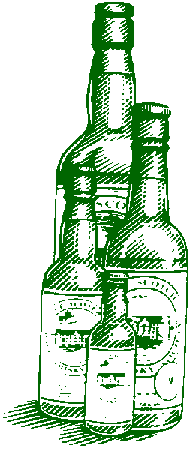 | for Bottle |
 | for Bottle |
 Whisky only began to be sold in bottleswhen blending became widespread, after 1860. Prior to this it wassold by the cask (usually about 10-12 gallons, for ease oftransportation) or by ceramic jars - known as a 'pigs' - ofvarying sizes up to about 5 gallons. Publicans dispensed thespirit direct from the jar/cask, or decanted it into their ownreceptacles and returned the casks or jars for refilling. Spiritsmerchants and private customers bottled their own stocks - inlarge private houses this was the butler's job.
Whisky only began to be sold in bottleswhen blending became widespread, after 1860. Prior to this it wassold by the cask (usually about 10-12 gallons, for ease oftransportation) or by ceramic jars - known as a 'pigs' - ofvarying sizes up to about 5 gallons. Publicans dispensed thespirit direct from the jar/cask, or decanted it into their ownreceptacles and returned the casks or jars for refilling. Spiritsmerchants and private customers bottled their own stocks - inlarge private houses this was the butler's job.
Readers will no doubt be drawing parallels between the waythings were done in days gone by and the way the Society buys andbottles its own malts today...
It was common for gentlemen to keep a cask in their cellar,and fill decanters direct from this. The splendid ProfessorGeorge Saintsbury recalls in his Notes on a Cellar-Book[published 1920, but covering the period 1885-1915}: "I usedto endeavour to supply my cask with, and to keep independent jarsof, the following:- Clyne Lish [sic], Smith's Glenlivet, GlenGrant, Talisker, and one of the Islay brands...I always keptsupplies of all, and amused myself with these, alone or variouslyblended, at intervals." What a good idea! Members take note!
Until the notoriously bigotted Central Control Board (LiquorTraffic) made it compulsory, in February 1917, to reduce thestrength of whisky to 40% alcohol by volume/70 degrees proof -and 28.6%ABV/50 degrees proof in munitions areas, which coveredmost of the main centres of population in Britain - it remainedcommon for pubs and many private customers to be supplied inbulk.
The attraction of sealed bottles for blenders was two-fold.They could guarantee the quality and consistency of the contents,and, accordingly, they could brand and promote their products toa world-wide market.
Remember that before the Spirits Act of 1860 allowed blendingin bond (i.e. prior to payment of duty) blending was only done ona very small scale and little attempt was made to producewhiskies of consistent quality. The man credited with producingthe first blended whisky made to a fixed and repeatable formulawas Andrew Usher of Edinburgh, who began offering Old VattedGlenlivet in London as early as 1844. His son, Andrew Usher II,developed this business massively, purchasing Glen Sciennes(malt) Distillery in 1860, and founding the North British (grain)distillery in 1885.
It is likely that Andrew II - and possibly even Andrew I - wasoffering his whiskies by the bottle as well as in largercontainers, but it is traditionally held that John Dewar was thefirst to sell his whiskies in branded bottles, in the late 1860s.This has been disputed by, among others, the Mackinlay family (asin The Original Mackinlay), who maintain that they were thefirst. In all likelihood many of the early large-scale blenders -Johnnie Walker, George Ballantine, John Haig, Arthur Bell and soon - began putting their whiskies in branded bottles about thesame time.
Bottles were used increasingly during the 1880s and 90s, notleast because of the widespread practice in poorer establishmentsof adulterating whisky with anything that came to hand. Prunewine, essence of sherry, green tea and turpentine were allpopular for flavouring; shellac added colour, methylated andBerlin spirits increased strength, sulphuric acid and varioussulphates improved beading! So great was the public fear thatwhisky might contain poisons that it became common practice toattach certificates from public analysts, testifying to thespirits purity and wholesomeness.
In this atmosphere of suspicion, trusted brand-namesflourished. And there was no shortage of extremely talented brandowners around in the '80s and '90s to exploit the situation - menlike James Buchanan (Black & White), Peter Mackie (WhiteHorse) Tommy Dewar (Dewar's White Label) and Alexander Walker(Johnnie Walker).
A final curiosity. Until 1913, bottles were sealed with adriven cork, requiring a corkscrew to open them, like winebottles. The replaceable cork was invented and patented byWilliam Manera Bergius, nephew of Adam Teacher (of Wm. Teacher& Sons). Teacher's Highland Cream was described as 'theself-opening bottle' and sold under the slogan 'Bury theCorkscrew'! The screw cap was introduced by White HorseDistillers in 1926, an innovation which doubled the sales of thebrand in six months, and this was further developed by White& Mackay, who, in 1960, introduced a plastic screw cap whichdoubled as a measure or small cup.
The fashion of the last few years has been to return to the'replaceable cork' for both malt and blended whisky-at last, andagain, involving all the senses in the enjoyment of Scotchwhisky. Readers will surely agree that the pop of the cork drawnfrom a new bottle of malt is one of the finest sounds on earth.
If you have comments about thissite, please contact the